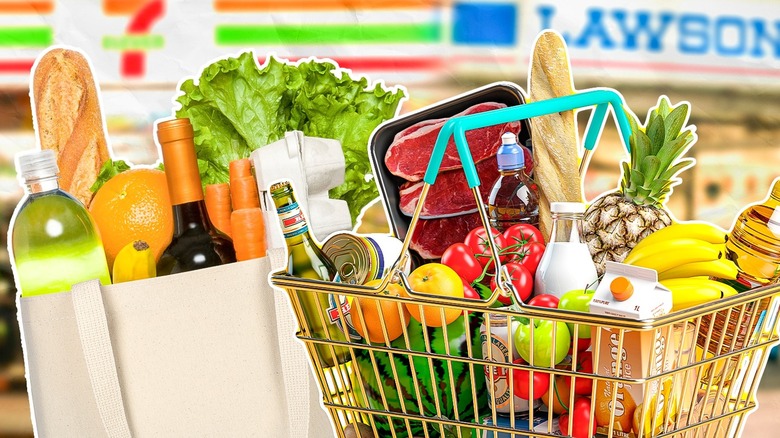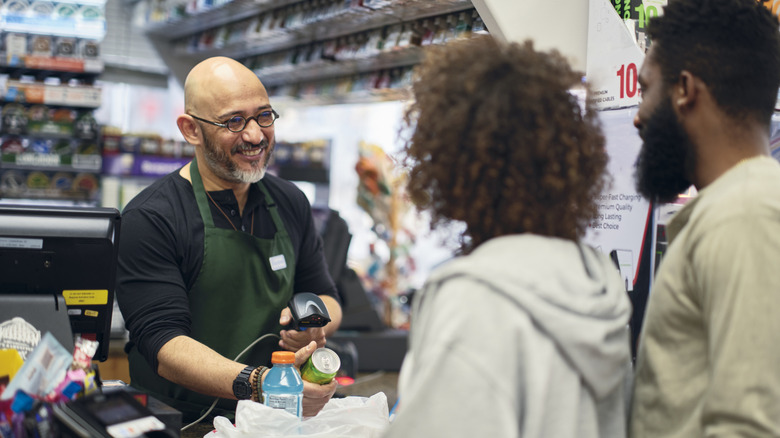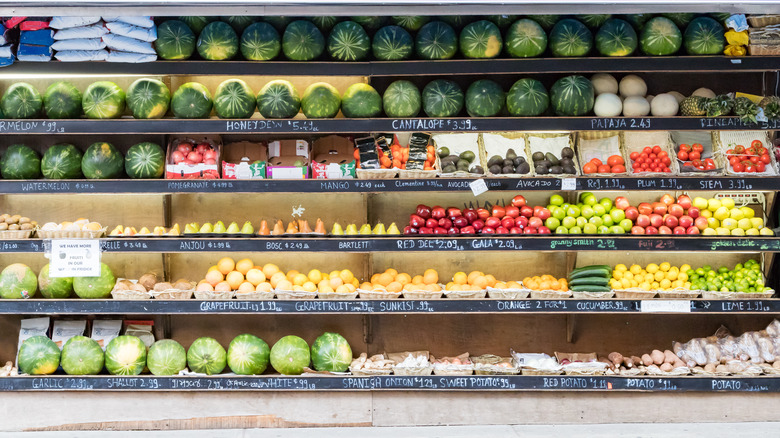How Corner Stores Became A Staple For Groceries Across The US
Convenience stores, mini marts, bodegas, markets, mom-and-pop shops — call them what you want, these small corner stores have become a staple for groceries across the U.S. That hasn't always been the case, however. Unlike in most European countries, Americans buy their groceries in bulk, which explains many of the differences between American and European supermarkets. A bulk shop every week at one of the big-name stores after work or over the weekend is usually enough to supply most Americans and their families with the meals and necessities they need until the next week rolls over.
Corner stores, for the most part, didn't stock the essentials like eggs, milk, or proteins, and were more so focused on supplying the grab-and-go snack options you'd typically find inside a gas station or 7-Eleven. But that's changing. For better or worse, few things were left unmarked by the COVID-19 pandemic — corner stores included. In response to social distancing measures, convenience store retailers shifted away from self-service food stations (which is too bad, because some U.S. corner stores serve the best food) and pivoted to items customers could prepare at home instead.
As a result, more and more people turned to them to supply pantry items, leading to an increase in grocery sales at 52% of corner stores in the U.S., according to a survey conducted by the National Association of Convenience Stores (NACS) (via Food Business News). Now, post-pandemic, the trend has only seemed to stick, providing shoppers with a less time-consuming and more convenient shopping alternative for groceries and daily essentials, both inner-city and out.
Putting the convenience in convenience store
Typically, when you think of a corner store, you picture one of those inner-city grocers in New York City — also known as a bodega. But these businesses offer pros for more rural and suburban communities, too. While they do have the added convenience of easy-to-find street parking — which, as most too-small Trader Joe's parking situations exemplify, would likely function as more of a hindrance within a city environment — what they really offer is a more time-efficient, less crowded shopping experience.
At a corner store, you won't run into the post-workday rush or the frustratingly long self-checkout lines. So, if it's mid-week and you realize you forgot to grab an extra dozen eggs or someone left the milk out, you don't have to dread facing the supermarket crowds. In cities, corner stores function more like community hubs. The reason these styles of businesses thrive in the fast-paced, city atmosphere is no secret: They're simply more convenient. Not only do they operate within smaller lots, but they also serve as a walkable source for daily necessities.
This allows customers to avoid the expensive fees that would come with online grocery delivery, without having to carry a double armful of groceries up to their sixth-floor walk-up apartment. Nor do they have to spend time on the train or request an Uber there and back — they just stop in to get what they need, when they need it. Where corner store businesses shine brightest, however, is in the role that they play in underserved communities.
Bridging food and food deserts
Food deserts are low-income geographic areas where residents — often unknowingly — have minimal access to grocery stores. Corner stores, while more often present, have long been criticized for lacking the fresh food items that locals in these areas need to live full, healthy lives. Fortunately, that's changed in the last few years. The intentional stocking of less processed foods (which can affect cognitive behavior) and more healthy grocery items makes corner stores the bridge between food and food deserts — not only feeding marginalized communities but also providing them with the nutritional resources they need to live and thrive.
Aside from the changes many stores have made to adapt since the COVID-19 pandemic, many American cities are also implementing initiatives to stock corner stores with more healthy and substantial food options. From Baltimore to Oakland, and Chicago to Minneapolis, cities aim to fill the nutrition gap by providing corner stores with Nutrition Incentives and Produce Prescription Projects. Both work with the Supplemental Nutrition Assistance Program (SNAP) and the Special Supplemental Nutrition Program for Women, Infants, and Children (WIC) assistance programs.
These initiatives don't just have the potential to increase profits for small businesses like corner stores but also present the possibility of reaching a higher population of people in need — many of which traditional supermarkets and retail stores can't. In food deserts, corner stores are more often than not the community's only source of food. By stocking these already established stores with healthier options, these determined programs are able to actively promote food justice, giving previously marginalized groups the nutritional access and purchasing power they need to reach their fullest potential.


